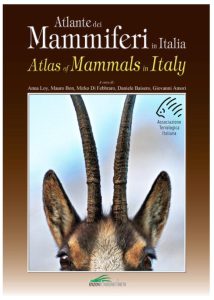
The volume, published by Edizioni Belvedere, will be presented on May 10 at 10:30 a.m. at the Charles Darwin Department of Biology and Biotechnology at La Sapienza, University of Rome, Viale dell’Università 32.
The first Atlas of Italian Mammals, edited by the Italian Teriological Association (ATIt), is a collective project contributed by 115 authors including several IRET researchers: Giovanni Amori, Leonardo Ancillotto, Paolo Colangelo, Emiliano Mori and Emanuela Solano.
The project was launched in 2019, with the publication of the Italian Mammals checklist, which provided the taxonomic context for the atlas.
The work covers 140 species of mammals present with stable populations in the Italian territory or seas. For each species, a bilingual (Italian and English) fact sheet was prepared describing its global and national distribution, taxonomy, ecology, conservation status in Italy, reference legislation, and IUCN categories at global and national levels.
The heart of the atlas, however, is the species distribution maps, which summarize, according to a European standard, all available occurrence data in 10×10-km grid cells. The maps were made using more than one million point reports, verified and validated as of 2021 by the authors. The 520-page volume is enhanced by more than 300 images of the mammals taken by more than 130 photographers.
The Atlas provides an up-to-date and valuable overview of the state of knowledge about mammals in Italy, particularly with respect to their distribution. Like most atlases, the distributional data are not derived from systematic censuses of all species over the entire national territory, but are based on the totality of available data. Therefore, any distributional gaps related to certain species do not necessarily correspond to their absence, but rather highlight the need to deepen their knowledge status. Finally, it is important to note that fauna distribution is a dynamic phenomenon, influenced by the ability of animals to move in response to environmental and biological factors. With this in mind, the atlas constitutes a constantly evolving “snapshot” that needs periodic updates from a solid knowledge base.

